Norfolk is treasure capital for detectorists, says museum
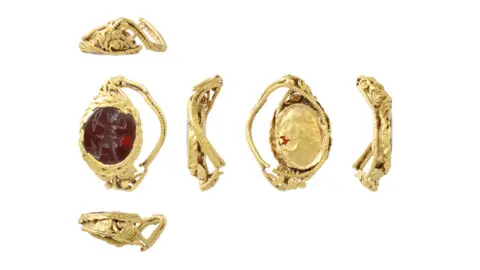 Andrew Williams/Norfolk County Council
Andrew Williams/Norfolk County CouncilMore treasure was discovered in Norfolk in 2022 than any other county, according to new figures.
Metal detectorists reported 95 finds in the county compared with 83 in Hampshire and 81 in Kent.
The British Museum, which runs the Portable Antiquity Scheme (PAS), said 2022 was a "record-breaking" year for reported finds.
Museum interim director Mark Jones thanked "the metal-detecting community" who recorded finds voluntarily.
Lincolnshire had the greatest number of finds overall - other than just items classed as treasure - with more than 5,101. Norfolk had 4,265 and Suffolk yielded 2,727.
Although the report covers 2022, the findings were revealed on Tuesday.
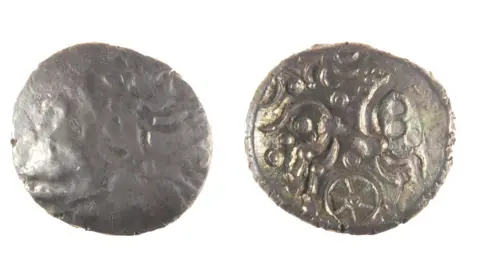 The Trustees of the British Museum
The Trustees of the British MuseumThere are a number of reasons for Norfolk remaining at the top of the treasure list, according to the county's finds liaison officer Helen Geake.
"Norfolk was always a very rich county, especially in days when riches depend on agriculture," she said.
"It's also very big, not very urban and very heavily ploughed, so things lost can be found and things buried can be eroded up to the top soil and found.
"And the third is we've worked with metal detectorists for a very long time and have a big team, so if something is found in Norfolk, people here know what to do."
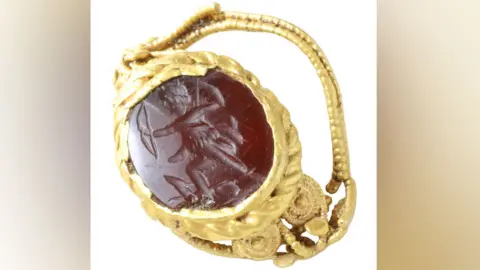 Andrew Williams/Norfolk County Council
Andrew Williams/Norfolk County CouncilA gold Roman ring, with a red gemstone carved with a figure of the goddess Diana, was among Norfolk's 2022 treasure finds, discovered in Sedgeford near King's Lynn.
The image is similar to one found on a pendant from the Thetford treasure hoard, suggesting it might have come from the same workshop.
As the Romans did give and receive wedding rings, Dr Geake said it could have been given as a love token.
 The Trustees of the British Museum
The Trustees of the British MuseumThe British Museum also announced some "significant" new finds made since 2022, including a late Bronze Age dress fastener.
The 3,000-year-old object was found in Staffordshire by detectorist Jonathan Needham and would have been used to fasten clothing.
Museum scientist Laura Perucchetti and curator Neil Wilkin examined the find and it is likely to be acquired by a museum.

What is treasure?
- Under the Treasure Act 1996, "treasure" includes prehistoric objects, coins that contain gold or silver and are at least 300 years old, or more recent valuable objects that have been deliberately hidden
- Finders of potential treasure in England, Wales and Northern Ireland are legally obliged to notify their local coroner
- An inquest then determines whether the finds constitute treasure
- If the find is declared treasure, the finder must offer it for sale to a museum at a price set by the British Museum's Treasure Valuation Committee
- A reward is then offered to the finders and other relevant parties, including the landowner

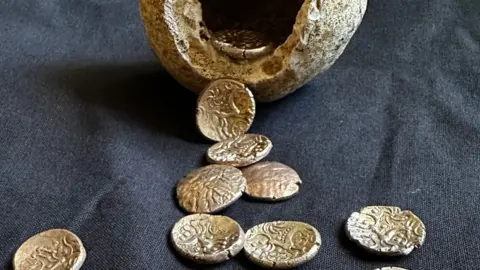 The Trustees of the British Museum
The Trustees of the British MuseumAnother extraordinary find was an Iron Age hoard of 26 Iron age gold coins, hidden inside a flint container.
It was discovered at East Garton in west Berkshire.
Pippa Pearce, senior conservator, said: "Every coin is a miniature document.
"To be understood, it has to be read and the role of conservation is to make this possible, revealing the hidden detail from beneath the concretions and corrosion built up during burial."
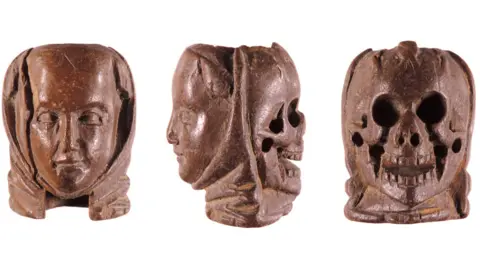 Trustees of the British Museum
Trustees of the British MuseumA third find announced by the museum was a carved rosary bead, dating to between 1450 and 1550, and unearthed in the City of London.
It measures 27mm (1in) high by 21mm (0.8in) wide and shows the face of a young woman on one side and a skull on the other.
Mr Jones said the finds recorded by the PAS "advance knowledge of past peoples, where and how they lived".
"As such, it reflects every part of human history, from the Palaeolithic to more modern times, across the whole of England and Wales," he said.

Follow East of England news on Facebook, Instagram and X. Got a story? Email [email protected] or WhatsApp 0800 169 1830
